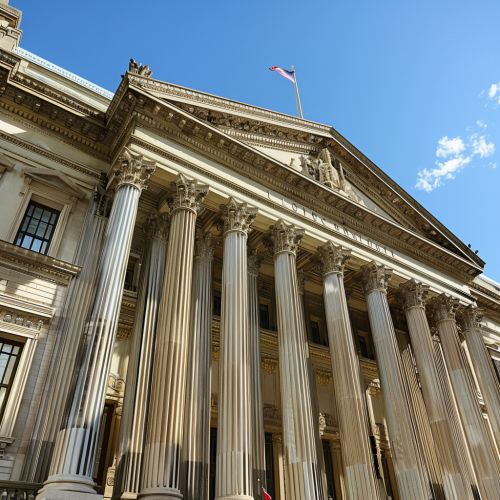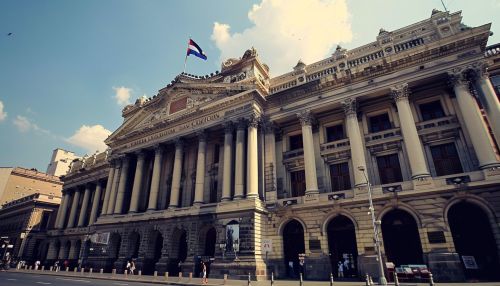Government Systems: Difference between revisions
No edit summary |
No edit summary |
||
| Line 40: | Line 40: | ||
Theocracy is a form of government in which religious leaders control the state, and religious law is used as the legal framework. Examples include Iran and the Vatican City. | Theocracy is a form of government in which religious leaders control the state, and religious law is used as the legal framework. Examples include Iran and the Vatican City. | ||
[[Image:Detail-79283.jpg|thumb|center|A grand government building with classical architecture, large columns, and a flag flying at the top.]] | [[Image:Detail-79283.jpg|thumb|center|A grand government building with classical architecture, large columns, and a flag flying at the top.|class=only_on_mobile]] | ||
[[Image:Detail-79284.jpg|thumb|center|A grand government building with classical architecture, large columns, and a flag flying at the top.|class=only_on_desktop]] | |||
=== Hybrid Systems === | === Hybrid Systems === | ||
Latest revision as of 21:38, 17 May 2024
Government Systems
Government systems are the frameworks through which political authority is exercised in a society. These systems determine how power is distributed, how decisions are made, and how policies are implemented. Understanding the various types of government systems is crucial for comprehending the complexities of political science and the functioning of different nations.
Types of Government Systems
Government systems can be broadly categorized into several types, each with distinct characteristics and mechanisms of governance. The primary types include:
Democracy
Democracy is a system of government where power is vested in the people, who rule either directly or through freely elected representatives. The core principles of democracy include political equality, majority rule, and the protection of minority rights. Democracies can be further divided into:
- **Direct Democracy**: In a direct democracy, citizens participate directly in decision-making processes. This form is rare in modern nation-states but can be seen in some local governments and referendums.
- **Representative Democracy**: Also known as a republic, this system involves the election of representatives who make decisions on behalf of the people. Examples include the United States and India.
Monarchy
Monarchy is a form of government where a single person, the monarch, holds supreme authority. Monarchies can be classified into:
- **Absolute Monarchy**: The monarch has almost complete control over the government and is not bound by a constitution or laws. Examples include Saudi Arabia and Brunei.
- **Constitutional Monarchy**: The monarch's powers are limited by a constitution or laws, and they often serve as ceremonial heads of state. Examples include the United Kingdom and Japan.
Authoritarianism
Authoritarianism is characterized by strong central power and limited political freedoms. Individual freedoms are subordinate to the state, and there is little political pluralism. Types of authoritarian regimes include:
- **Dictatorship**: One person or a small group holds absolute power, often maintained through force or propaganda. Examples include North Korea and Belarus.
- **Military Junta**: A government led by a committee of military leaders. Examples include Myanmar and Thailand (during certain periods).
Totalitarianism
Totalitarianism is an extreme form of authoritarianism where the state seeks to control nearly every aspect of public and private life. Totalitarian regimes often employ propaganda, surveillance, and state terror to maintain control. Historical examples include Nazi Germany and the Soviet Union under Stalin.
Oligarchy
Oligarchy is a system where power resides with a small number of people, often distinguished by nobility, wealth, family ties, education, or corporate, religious, or military control. Examples include Russia and China, where power is concentrated among elite groups.
Theocracy
Theocracy is a form of government in which religious leaders control the state, and religious law is used as the legal framework. Examples include Iran and the Vatican City.


Hybrid Systems
Many modern states employ hybrid systems that incorporate elements from multiple types of government systems. These hybrids can provide a balance between different governance principles, such as combining democratic processes with authoritarian control. Examples include:
- **Semi-Presidential Systems**: These systems combine aspects of presidential and parliamentary systems. The president and prime minister share executive powers. Examples include France and Russia.
- **Federal Systems**: Power is divided between a central government and regional governments. This allows for a balance of power and local autonomy. Examples include the United States and Germany.
Functions of Government
Governments perform several essential functions to maintain order and provide services to citizens. These functions include:
- **Legislation**: Creating laws that govern society.
- **Administration**: Implementing and enforcing laws.
- **Judiciary**: Interpreting laws and administering justice.
- **Defense**: Protecting the nation from external threats.
- **Public Services**: Providing essential services such as healthcare, education, and infrastructure.
Political Theories
Various political theories provide frameworks for understanding and analyzing government systems. Some of the most influential theories include:
- **Liberalism**: Advocates for individual freedoms, democracy, and free markets.
- **Marxism**: Focuses on class struggle and the role of capitalism in shaping societies.
- **Conservatism**: Emphasizes tradition, social stability, and maintaining established institutions.
- **Libertarianism**: Advocates for minimal government intervention in personal and economic affairs.
Evolution of Government Systems
Government systems have evolved over time, influenced by historical events, cultural shifts, and technological advancements. Key historical developments include:
- **Ancient Governments**: Early forms of government, such as city-states in Mesopotamia and Greece, laid the foundation for modern political systems.
- **Feudalism**: A medieval European system where land was exchanged for military service and labor.
- **Colonialism**: The expansion of European powers and the establishment of colonies around the world.
- **Modern Nation-States**: The development of sovereign states with centralized governments and defined borders.
Challenges and Criticisms
Each type of government system faces unique challenges and criticisms. Common issues include:
- **Corruption**: The abuse of power for personal gain.
- **Inequality**: Disparities in wealth, power, and opportunities.
- **Human Rights Violations**: Suppression of freedoms and rights.
- **Political Instability**: Frequent changes in government or civil unrest.
Conclusion
Understanding government systems is essential for analyzing political dynamics and the functioning of societies. Each system has its strengths and weaknesses, and the choice of system can significantly impact a nation's stability, prosperity, and citizens' quality of life.
